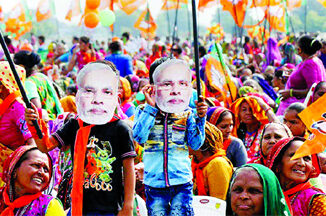
In the last 76 years, India has emerged with new dynamics and has made significant progress in various spheres like the economy, healthcare, education, space, and technology among others. After freeing itself from the clutches of the British rulers, over the next decades India had taken some crucial steps to improve healthcare accessibility and availability. Post-independence India’s most noteworthy achievement, in the public health arena, has been the decrease in death rates (mortality). From launching national-level and ambitious initiatives to reducing and controlling some of the deadly diseases, India has come a long way. Let’s have a look at some of the important achievements of India’s healthcare system in the last 76 years:
Improved Life Expectancy
In the last 76 years, India has improved tremendously with respect to life expectancy. In 1947, the expectancy of an average Indian citizen was around 32 years and it has increased to 70.42 years in 2023. The increase in life expectancy in the last 76 years has been over 100 per cent. United Nations-World Population Perspective states that the average global life expectancy is 72.98 years. According to the World Health Organization (WHO), India has significantly improved its people’s health outcomes. According to experts, life expectancy is one of the most important and most used indicators for human development. Several studies have revealed that India’s life expectancy has increased due to the better availability of treatments, medicines, and evolving technology. The current life expectancy for India in 2023 is 70.42 years which is a 0.33 per cent increase from 2022. Experts opine that there have been significant enhancements in infant and child mortality along with maternal mortality that has led to the longevity of life in the country.
Decline in Child, maternal mortality rate
According to United Nation projections, India’s current infant mortality rate in 2023 is 26.619 deaths per 1000 live births, 3.89% decline from 2022. The findings of the National Health Family Survey-5 (NHFS-5) revealed that IMR has marginally declined in nearly all states and Assam has seen one of the largest drops in IMR, from 48 deaths (per 1,000 live births) to 32 deaths.
Meanwhile, in the 1940s, the Maternal mortality ratio (MMR) was 2000/100,000 live births, which apparently came down to 1000 in the 1950s. Moreover, India is also a signatory to the United Nations (UN) Sustainable Development Goals (SDGs), which adopted a global maternal mortality ratio (MMR) target of fewer than 70 deaths per 100 000 live births by 2030. The Registrar General of India says the MMR has declined by 10 points. It has declined from 113 in 2016-18 to 103 in 2017-19 which is an 8.8 per cent decline.
Control of Communicable Diseases:
Since gaining independence, India has launched several national programmes to curb the menace of communicable diseases like Malaria, Tuberculosis, and AIDS, among others. According to a study published in the American Journal of Tropical Medicine and Hygiene, in 1947, 75 million malaria cases in a population of 330 million were estimated in India. During the eradication era in the late 1950s and early 1960s, a spectacular achievement was witnessed on the malaria eradication front because malaria cases significantly declined to just 100,000 in 1964. Despite the reversal which led to around 6.4 million cases in 1976, the cases of malaria have declined significantly over the year. According to the WHO’s latest World Malaria Report 2021, of the world’s 11 highest burden countries, only India registered progress against malaria. Meanwhile, India’s success in Polio has been acclaimed around the globe. Until the early 1990s, Polio was hyperendemic in India, with an average of 500 to 1000 children getting paralysed daily. India was declared Polio free in 2014 and no new case of Polio has been reported in the country since January 2011. With respect to Leprosy, India is running one of the largest leprosy eradication programme in the world, the National Leprosy Eradication Program (NLEP). India’s performance in smallpox eradication has been commendable too. After years of being one of the countries with the highest number of smallpox cases, the country declared itself smallpox free in 1979. Similarly, India has made significant progress in controlling diseases like Tuberculosis, Cholera, Kala Azhar, and HIV.
Healthcare policies and govt schemes
Since India became independent in 1947, the government has launched various policies and schemes to improve healthcare facilities in the country. Over the decades, the government has launched schemes like National Health Mission (NHM) and National Rural Health Mission (NRHM) to improve child and maternal health. Meanwhile, there are schemes that are launched as a part of these missions including Janani Suraksha Yojana (JSY) enables direct cash transfer to pregnant mothers, Janani Shishu Suraksha Karyakram (JSSK)allows pregnant mothers to deliver in government hospitals for free, Pradhan Mantri Surakshit Matrutva Abhiyan (PMSMA) focuses on providing good antenatal care and specifically identifying and managing high-risk pregnant mothers. In 2018, a centrally-sponsored Ayushman Bharat Pradhan Mantri Jan Arogya Yojana (AB PM-JAY) was launched which is the largest Government funded health assurance/insurance scheme in the world. In this scheme, financial risk protection is provided by the government against catastrophic health expenditure that impoverishes an estimated 6 crore people every year. Moreover, the government has launched several other schemes like Pradhan Mantri Swasthya Suraksha Yojana (PMSSY), enhanced the quality of medical education in the country and the extensive improvement in healthcare infrastructure since independence. With over 92,000 seats, there are now 612 medical colleges in India as compared to 28 in the 1950s.
Public healthcare is free for every Indian resident. The Indian public health sector encompasses 18% of total outpatient care and 44% of total inpatient care. Middle and upper class individuals living in India tend to use public healthcare less than those with a lower standard of living. Additionally, women and the elderly are more likely to use public services. The public health care system was originally developed in order to provide a means to healthcare access regardless of socioeconomic status or caste. However, reliance on public and private healthcare sectors varies significantly between states. Several reasons are cited for relying on the private rather than public sector; the main reason at the national level is poor quality of care in the public sector, with more than 57% of households pointing to this as the reason for a preference for private health care. Much of the public healthcare sector caters to the rural areas, and the poor quality arises from the reluctance of experienced healthcare providers to visit the rural areas. Consequently, the majority of the public healthcare system catering to the rural and remote areas relies on inexperienced and unmotivated interns who are mandated to spend time in public healthcare clinics as part of their curricular requirement. Other major reasons are long distances between public hospitals and residential areas, long wait times, and inconvenient hours of operation.
Major challenges
India has made significant strides in its healthcare sector, however, there remain several challenges that need to be addressed.
Five main interrelated challenges facing India’s population: cardiovascular diseases, cancers, chronic respiratory diseases, diabetes, and obesity.
Rising obesity rates, particularly in Delhi, Tamil Nadu, Kerala, Punjab, Telangana, Andhra Pradesh, and Karnataka, increase the risk of other health issues.
Building awareness and promoting healthy lifestyles is necessary to save lives and prevent chronic medical conditions.
Infrastructure
The state of infrastructure varies across states with some having better arrangements than others.
Urban areas need to bridge the gap in hospital services between large urban areas and tier II and III cities. Standalone hospitals and nursing homes provide much-needed service but are unable to provide multi-speciality, leave alone tertiary and quaternary care.
The gaps between services available in metros and big cities and in districts must be bridged.
Health Insurance
Over the past three years, more than four crore Indians have bought health insurance. Ayushman Bharat insurance scheme for 10 crore poor families provides insurance against hospitalization for up to Rs 5 lakh per year per family. Nearly 74 per cent of Indians are either covered or eligible for health insurance coverage, but millions remain uninsured. Out-patient doctor consultation costs, diagnostics, and drugs remain a financial burden for many.





Be the first to comment